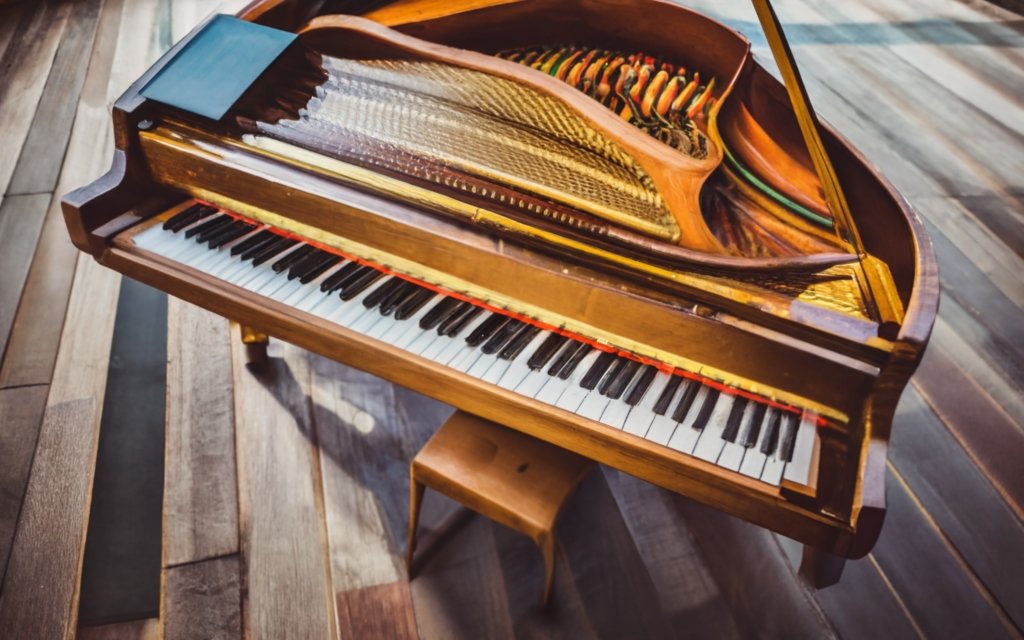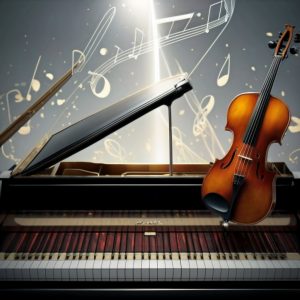In the realm of musical instruments, few captivate the imagination and defy categorization quite like the piano. Its sonorous melodies and thunderous chords prompt a question that echoes through concert halls and music studios alike: is the piano a stringed instrument or a percussion instrument?
In the symphony of classifications, the piano occupies a unique position, embracing a dual identity that bridges the worlds of strings and percussion. Many musicians often wonder if the piano is a string instrument or a percussion instrument.
Join us as we unravel the harmonious paradox that is the piano, discovering the magic that emerges when strings and percussion converge in a symphony of sound.

Exploring the anatomy of a piano
To answer the question of is a piano a string instrument, first we need to explore the anatomy of the piano. The piano is a marvel of engineering, its design carefully crafted to blend the harmonic resonance of strings with the percussive force of hammers.
At its core, the piano comprises several key structural components that contribute to its dual identity as both a string and percussion instrument that are important to understand as you learn to play the piano.
The strings, fundamental to the piano’s tonal range, are stretched across a cast-iron frame, creating a network of tensioned elements. These strings come in varying thicknesses and lengths, each responsible for producing distinct pitches. As a pianist presses a key, a complex system of levers and hammers is set into motion.
The action mechanism, an intricate assembly of levers and springs, is the engine behind the piano’s ability to produce sound. This interaction between the keys, hammers, and strings forms the foundation of the piano’s sound production, showcasing its string instrument lineage.
Simultaneously, the cast-iron frame provides stability and support, crucial for maintaining the tension of the strings. This structural integrity ensures that the piano can withstand the immense forces exerted during play, contributing to its longevity and reliability as a musical instrument.
So is a piano a string instrument?
Is a piano a string instrument? The piano’s classification as a string instrument finds its roots in the distinct characteristics shared with traditional members of this musical family. String instruments are renowned for their ability to produce sound through the vibration of taut strings, and the piano aligns seamlessly with these defining features.
Why is piano a string instrument?
One primary characteristic shared with other string instruments is the reliance on strings to generate sound. The piano’s strings are meticulously crafted to produce a wide spectrum of tones, ranging from deep, resonant bass notes to delicate, high-pitched trebles. This versatility mirrors the tonal capabilities inherent in other classical string instruments, such as the violin or cello, and the ability to achieve the tonality required to play things like major and minor chords and more complicated harmony.
Moreover, the piano’s method of sound production involves the manipulation of string tension. As a pianist strikes a key, the hammer makes contact with the corresponding string, setting it into vibration. This manipulation of tension directly influences the pitch and timbre of the produced sound, a fundamental trait shared with traditional string instruments.
Historically, the idea that a piano is a string instrument is evident in its evolution from earlier keyboard instruments, such as the harpsichord and clavichord. These predecessors had a more direct connection to traditional strings, laying the groundwork for the piano’s eventual development as a powerful and expressive string instrument.
The piano’s adherence to key characteristics of string instruments, its reliance on strings for sound production, and its historical lineage all contribute to a compelling argument for recognizing that the piano is a string instrument.
The case for piano as a percussion instrument
Is piano a percussion instrument? While the piano’s association with strings is undeniable, its rhythmic and percussive qualities equally position it within the realm of percussion instruments. Examining the characteristics shared with traditional percussion instruments sheds light on this often-overlooked facet of the piano’s identity.
An essential characteristic of percussion instruments is their role in establishing rhythm and beat within a musical composition. The piano, through its hammer and string mechanism, contributes not only melodic elements but also rhythmic precision. The percussive attack of the hammers against the strings allows the piano to articulate nuanced rhythms, showcasing its percussion-like qualities.
Furthermore, the piano’s role in ensembles and orchestras often mirrors that of traditional percussion instruments. Its ability to punctuate musical phrases, provide accents, and contribute to the overall rhythmic texture aligns with the fundamental functions of percussion within a musical ensemble.
The piano’s historical evolution also underscores its percussive nature. As it emerged from early keyboard instruments, the emphasis on hammers striking strings became a defining feature, contributing to its rhythmic versatility and answering the question of is piano a percussion instrument.
The piano’s percussive qualities, manifested through the striking action of hammers, rhythmic contributions, and historical development, make a compelling case for recognizing it as a dynamic member of the percussion instrument family.

Comparative analysis of instrument classifications
To truly appreciate the piano’s unique dual identity, it’s essential to situate it within the broader context of instrument classifications, each distinguished by its distinctive characteristics and sound production methods.
Woodwind instruments
Woodwinds, known for producing sound through vibrating columns of air, stand in stark contrast to the piano’s mechanism. The piano’s absence of reeds or air columns places it outside the woodwind family, emphasizing its distinctive nature as a keyboard instrument.
Brass instruments
Brass instruments generate sound through the vibration of players’ lips against a brass mouthpiece. The piano, devoid of such brass components or the need for manual blowing, clearly differs from the brass family. Its sound is created through the interaction of hammers and strings, showcasing a fundamentally different approach to musical expression.
String instruments
As previously explored, the piano shares undeniable affinities with traditional string instruments. Its reliance on taut strings for sound production, manipulation of string tension, and historical connection to early stringed keyboard instruments firmly places it within the string family. Lower register string instruments, like the upright bass, generally handle the bass clef notes. Some middle register string instruments, like cello and viola, are written in alto or tenor clef.
Percussion instruments
Percussion instruments, characterized by the striking or shaking of surfaces, present another facet of the piano’s identity. The piano’s percussive nature, embodied in the hammer-and-string mechanism, aligns it with the rhythmic qualities of percussion instruments. Its ability to punctuate, accentuate, and contribute to the overall rhythmic structure positions it as a versatile member of the percussion family.
A class of its own
The piano defies easy categorization within a single instrument family. Instead, its unique combination of string and percussion elements allows it to bridge multiple classifications. This dual nature makes the piano a truly exceptional and versatile instrument, capable of producing a wide array of sounds that enrich the musical landscape.
Historical and cultural context of the piano
The piano’s rich history and cultural significance have woven it into the fabric of musical evolution, making it an instrument of enduring appeal and versatility.
The roots of the piano can be traced back to the early keyboard instruments of the 17th century, such as the harpsichord and clavichord. The desire for greater expressive possibilities and dynamic range led to the development of the pianoforte, an early version of the piano, in the late 17th century. Over the following centuries, innovations in design, materials, and construction techniques refined the instrument into the modern piano we know today.
The Industrial Revolution played a pivotal role in the mass production of pianos, democratizing access to music and contributing to the instrument’s widespread popularity. The piano’s evolution from a luxurious item in aristocratic households to a common fixture in middle-class homes marked a significant shift in the democratization of music.
Cultural significance and evolution in musical genres
The piano’s cultural significance extends across various musical genres, reflecting and influencing the changing tastes of societies. In classical music, the piano became a staple instrument, with composers like Mozart, Beethoven, and Chopin composing iconic works that showcased its expressive capabilities and strong piano chord progressions.
As music evolved into the 20th century, the piano seamlessly adapted to new genres. In jazz, the piano emerged as a central instrument, with virtuosos like Duke Ellington and Thelonious Monk pushing the boundaries of improvisation. In the realm of popular music, the piano’s role expanded, with artists like Elton John and Billy Joel making it a focal point of their compositions.
The versatility of piano notes and their ability to convey a wide range of emotions have made it a fixture in nearly every musical genre, from classical and jazz to rock, pop, blues and beyond. Its cultural impact extends beyond the concert hall, with the piano becoming a symbol of musical expression and creativity in diverse communities around the world.
Expert opinions and musical perspectives
To gain a deeper understanding of the piano’s dual classification, it’s valuable to explore the insights of musicians, composers, and musicologists who have delved into the intricacies of this remarkable instrument.
Insights from musicians
Renowned pianists often emphasize the nuanced control they have over both the strings and percussive elements of the piano. The celebrated pianist Martha Argerich, for instance, has remarked on the instrument’s unique ability to convey a wide spectrum of emotions through its combination of melodic expression and rhythmic precision. This dual nature, she suggests, grants pianists a broad palette for artistic interpretation.
Perspectives from composers
Composers, in their exploration of the piano’s capabilities, frequently exploit its dual identity. Beethoven, a pivotal figure in classical music, composed works that showcase the piano’s capacity for both delicate lyricism and thunderous percussive power. Contemporary composers, such as Philip Glass, continue to push the boundaries of piano composition, experimenting with repetitive patterns that highlight its rhythmic potential.
Reflections from musicologists
From a scholarly standpoint, musicologists often examine the piano’s historical evolution and its impact on musical genres. Dr. Susan Tomes, a respected musicologist, has explored the intricate relationship between the piano’s construction and its expressive possibilities. Her work delves into how the instrument’s design influences the performer’s interpretation, bridging the gap between its string and percussion elements.
Impact on composers and performers
The dual classification of the piano significantly influences how composers approach composition and how performers interpret and express musical ideas. Composers, aware of the piano’s unique capabilities, may intentionally exploit its percussive qualities in rhythmic compositions or showcase its string-like resonance in more lyrical passages.
For performers, understanding the instrument’s dual nature is pivotal for conveying the composer’s intentions. Pianists often articulate how the tactile connection with the keys allows them to navigate seamlessly between the percussive and melodic aspects, enabling them to craft nuanced performances that capture the essence of a diverse range of musical genres.
Expert opinions from musicians, composers, and musicologists collectively highlight the piano’s dual nature as both a string and percussion instrument. These insights offer a comprehensive perspective on how this duality influences artistic expression and shapes the creative processes of those who compose for and perform on this extraordinary instrument.
Embracing the piano’s unique identity
As we’ve explored, the piano’s classification as both a string and percussion instrument is not a mere technicality but a key to unlocking its expressive depth. Its strings resonate with the soulful echoes of tradition, connecting it to the rich legacy of classical music. Simultaneously, its percussive heartbeat pulses through genres like jazz, pop, and rock, making it a rhythmic cornerstone in the ever-evolving landscape of contemporary music.
Embracing the piano’s dual persona allows us to appreciate its timeless allure and ensures that its music will continue to resonate across genres, cultures, and generations, leaving an indelible mark on the ever-evolving journey of musical expression.
Join us at Skoove to learn and explore more about the history of the piano. With interactive online piano lessons, real-time feedback, and a diverse music library, Skoove caters to learners of all levels, making piano education accessible, engaging, and effective.
Author of this blog post:

Eddie Bond is a multi-instrumentalist performer, composer, and music instructor currently based in Seattle, Washington USA. He has performed extensively in the US, Canada, Argentina, and China, released over 40 albums, and has over a decade experience working with music students of all ages and ability levels.















